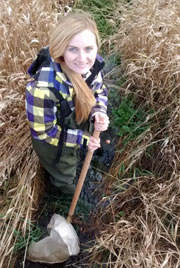Surviving the storm: What happens after the trees come down?
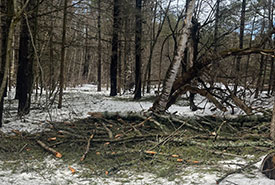
Downed trees in Gillies Grove after the freezing rain thunderstorm in spring 2023 (Photo by NCC)
Whenever we experience a big storm in eastern Ontario, my thoughts turn to the Gillies Grove Nature Reserve. Home to some of the last remaining old-growth forest in eastern Ontario, this Nature Conservancy of Canada (NCC) project is considered ecologically significant. The community is invited to experience and share in this special property by walking its five kilometres of trails. It’s one of my favourite places in the world, and getting to care for it as NCC’s coordinator of conservation biology for eastern Ontario is a highlight of my job.
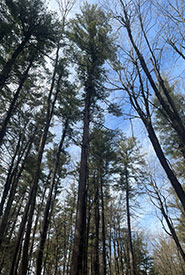
Ontario's tallest tree, an eastern white pine (Photo by NCC)
Walking under the canopy of Ontario’s tallest tree — a 47-metre-tall eastern white pine estimated to be over 150 years old — I often think about the storms it has seen. No doubt, this tree and its neighbours have experienced rain, wind, heat, lightning, snow and drought, growing stronger year after year with each new growth ring.
This spring, eastern Ontario experienced a freezing rain thunderstorm, an uncommon but severe weather event that brought up to 50 millimetres of freezing rain across the region. As ice coats trees during a storm such as this, the trees become remarkably heavy, eventually breaking branches and possibly even being uprooted. In an old-growth forest like Gillies Grove, severe weather events like this can cause a lot of damage.
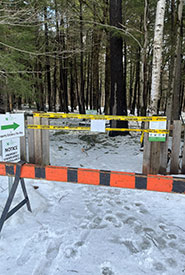
Gillies Grove: the entrance to the property closed off due to post-storm hazards. (Photo by NCC)
Storms create hazards you can visually see, like downed trees and scattered branches, but there are also hazards that are less obvious. When branches break in a storm, they can get caught in the canopy. As the weather changes, these branches are prone to falling, even after the storm has passed. NCC’s first priority after a storm is to ensure the safety of visitors to our nature reserves. Gillies Grove is so much more than a nature reserve; it’s a community space where people walk to school and work, socialize with friends and get away from the busyness of life while spending time in and connecting with nature.
Despite dealing with my own storm aftermath, which included my home being without power or water, my job the day after the storm was to close Gillies Grove until our arborist could clear the hazards. It’s hard not to feel sad taking in the sight of broken branches and fallen trees. As I worked my way around the property, hard hat on my head, I held my breath, hoping Ontario’s tallest tree would be okay. And while it lost a few branches, I was pleased to see the mighty pine was still standing. The squirrels didn’t seem to mind, as the only companions on my walk, they darted across fallen tree limbs, exploring the changes in their neighbourhood.
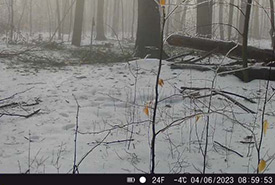
A trail cam view of Gillies Grove during the storm. Branches can be seen coated with ice (Photo by NCC)
As we experience more intense and frequent storms each year, the effects of climate change are undeniable, and these events will continue to become more intense and frequent. Our forests are remarkably resilient, but events like this put them under pressure. Other factors, including increased disease, invasive species and habitat fragmentation, all weaken our forests and make them more susceptible to disease and invasive species infestation, and falling or breaking when these storms do come around.
That’s where NCC comes in. As Canada’s largest land conservation charity, we have protected over 15 million hectares of important habitat across the country, including old-growth forest like Gillies Grove. We see the pressures we face as a society, including habitat and biodiversity loss, as well as extreme weather patterns. That’s why we’re committed to doubling the pace of conservation, and conserving even more land. When land is conserved, we can steward and restore it to make sure it’s resilient. One tree standing by itself is prone to breaking, but when protected by an entire forest, we can give those trees and the species that depend on them a fighting chance.
The initial sadness is soon replaced by hope. This is not the first storm to pass through Gillies Grove, and it won’t be the last. It’s important to remember that just because a tree has fallen, its life cycle isn’t finished. Broken trunks become habitat for bats, woodpeckers and flying squirrels, and fallen branches decompose to return nutrients to the soil. When we work with arborists, we try to balance protecting as much of the habitat as possible with making the area safe to visit. The empty spaces left by the big trees will allow light to reach the ground, and encourage the next generation of plants to grow. So, although we’re always sad to lose big, old trees, the forest will carry on.
As I finished my walk through the nature reserve, I was treated to the sight of some eastern white pine saplings. These small trees, currently only waist height, are the giants of tomorrow. I’m proud to play a role in ensuring that, one day, they too will tower above the trails at Gillies Grove.

